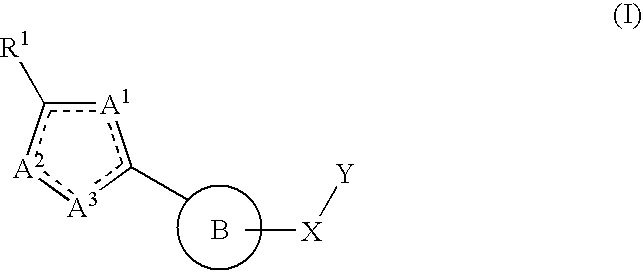Therapeutic isoxazole compounds
a technology of isoxazole and compound, applied in the field of therapeutic isoxazole compounds, to achieve the effect of enhancing cognitive function
- Summary
- Abstract
- Description
- Claims
- Application Information
AI Technical Summary
Benefits of technology
Problems solved by technology
Method used
Image
Examples
example 24 and 25
Preparative Example 24 and 25
[0392]
5-(3-Difluoromethyl-4-methyl-isoxazol-5-yl)-thiophene-2-carboxylic acid ethyl ester and 5-(5-Difluoromethyl-4-methyl-isoxazol-3-yl)-thiophene-2-carboxylic acid ethyl ester
[0393]Prepared from 5-(4,4-Difluoro-2-methyl-3-oxo-butyryl)-thiophene-2-carboxylic acid ethyl ester by the method described in Preparative Example 10. The crude material was chromatographed on silica gel with EtOAc / hexanes (10%) as eluant and the pure fractions isolated to afford products as colorless solids. High Rf material (Rf=0.40, 440 mg, 9%), low Rf material (Rf=0.24, 1.1 g, 22%), as well as an approximately 1:1 mixture of isomers (1.5 g, 30%).
[0394]Higher Rf Product: 5-(3-Difluoromethyl-4-methyl-isoxazol-5-yl)-thiophene-2-carboxylic acid ethyl ester: 1H NMR (CDCl3) 1.41 (t, J=7.0, 3 H), 2.38 (s, 3 H), 4.38 (q, J=7.0, 2 H), 6.80 (t, J=53.2, 1 H), 7.51 (d, J=4.4, 1 H), 7.82 (d, J=4.4, 1 H). 13C NMR 7.7, 14.5, 61.9, 109.5, 110.3 (t, J=236), 127.5, 133.7, 134.1, 136.3, 158.7 (t...
example 1
[0418]
Piperidin-1-yl-[5-(5-trifluoromethyl-isoxazol-3-yl)-thiophen-2-yl]-methanone
[0419]A solution of 4,4,4-Trifluoro-1-[5-(piperidine-1-carbonyl)-thiophen-2-yl]-butane-1,3-dione (Preparative Example 3, 333 mg, 1 mmol) in glacial acetic acid (2.5 mL) was treated with hydroxylamine hydrochloride (73 mg, 1.05 mol) and heated at 80-90° C. for 24 hr, after which time the reaction was evaporated and filtered with the aid of 30% EtOAc / hexanes to afford the 5-hydroxy-4,5,-dihydro-isoxazole intermediate (225 mg). The intermediate was then dissolved in trifluoroacetic acid (2.5 mL) and heated at reflux for 3 days. The reaction was then evaporated and the residue chromatographed on silica gel with EtOAc / hexanes (30 then 50%) as eluant to afford product as a colorless solid (105 mg, 32%). 1H NMR (CDCl3) 1.65-1.73 (m, 6 H), 3.66-3.69 (m, 4 H), 6.95 (s, 1 H), 7.28 (d, J=4.0, 1 H), 7.44 (d, J=4.0, 1 H). 13C NMR 24.7, 26.4, 47.0 (br), 103.7, 110.0, 114.3 (q, J=267), 128.0, 129.0, 131.0, 140.9, 155...
example 2
[0420]
[5-(4-Methyl-5-trifluoromethyl-isoxazol-3-yl)-thiophen-2-yl]-piperidin-1-yl-methanone
Method A
[0421]Prepared from 4,4,4-Trifluoro-2-methyl-1-[5-(piperidine-1-carbonyl)-thiophen-2-yl]-butane-1,3-dione as described in Example 1. Chromatographed on silica gel with EtOAc / hexanes (40%) as eluant to afford product as a colorless solid (90 mg, 26%). 1H NMR (CDCl3) 1.62-1.68 (m, 6 H), 2.33 (d, J=1.3, 3 H), 3.64-3.67 (m, 4 H), 7.28 (d, J=4.0, 1 H), 7.41 (d, J=3.5, 1 H). 13C NMR 7.9, 24.7, 26.3, 46.0 (br), 114.7, 118.8 (q, J=271), 128.0, 129.0, 131.0, 140.3, 155.1 (q, J=40), 158.0, 162.3. 19F NMR −63.2. LC / MS 7.92 min, [M+1]+ 344.
Method B
[0422]A solution of 5-(4-Methyl-5-trifluoromethyl-isoxazol-3-yl)-thiophene-2-carboxylic acid (Preparative Example 14, 139 mg, 0.5 mmol) in toluene (5 mL) was treated with DMF (˜5 μL) followed by oxalyl chloride (85 μL, 1.0 mmol). The reaction was allowed to stir for 2 hr at room temperature and 1 hr at 40° C. The reaction was then concentrated in vacuo t...
PUM
 Login to View More
Login to View More Abstract
Description
Claims
Application Information
 Login to View More
Login to View More - R&D
- Intellectual Property
- Life Sciences
- Materials
- Tech Scout
- Unparalleled Data Quality
- Higher Quality Content
- 60% Fewer Hallucinations
Browse by: Latest US Patents, China's latest patents, Technical Efficacy Thesaurus, Application Domain, Technology Topic, Popular Technical Reports.
© 2025 PatSnap. All rights reserved.Legal|Privacy policy|Modern Slavery Act Transparency Statement|Sitemap|About US| Contact US: help@patsnap.com



